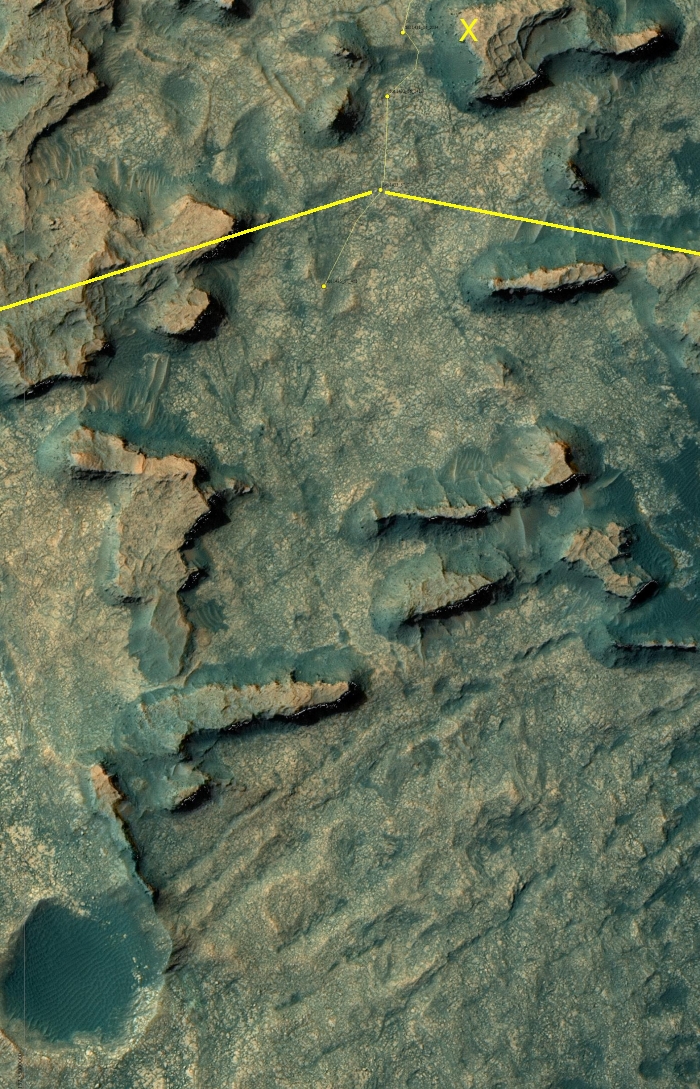Beyond Murray Buttes

Time for a Curiosity update. Above is a panorama I’ve created from raw images released today from the rover’s left navigation camera of the mesa filled terrain within which Curiosity now sits. Since my last update they have traveled about 200 feet south, moving away from the mesa with the balanced rock
Below the fold is a Mars Reconnaissance Orbiter image with Curiosity’s path indicated. I have marked the balanced rock with an X, and have indicated with the yellow lines the area covered by the panorama above.
They appear to be aiming due south for the narrow gap between the long ridge-like mesas. This will bring Curiosity out into the open and sloping terrain that can be seen in the distance in the last image of my last update. I suspect they want to get a closer look at those parallel grooves, even if it means the journey will be a little rougher.

On Christmas Eve 1968 three Americans became the first humans to visit another world. What they did to celebrate was unexpected and profound, and will be remembered throughout all human history. Genesis: the Story of Apollo 8, Robert Zimmerman's classic history of humanity's first journey to another world, tells that story, and it is now available as both an ebook and an audiobook, both with a foreword by Valerie Anders and a new introduction by Robert Zimmerman.
The print edition can be purchased at Amazon or from any other book seller. If you want an autographed copy the price is $60 for the hardback and $45 for the paperback, plus $8 shipping for each. Go here for purchasing details. The ebook is available everywhere for $5.99 (before discount) at amazon, or direct from my ebook publisher, ebookit. If you buy it from ebookit you don't support the big tech companies and the author gets a bigger cut much sooner.
The audiobook is also available at all these vendors, and is also free with a 30-day trial membership to Audible.
"Not simply about one mission, [Genesis] is also the history of America's quest for the moon... Zimmerman has done a masterful job of tying disparate events together into a solid account of one of America's greatest human triumphs."--San Antonio Express-News


Robert, you’re a cave enthusiast. Do you have any idea if liquid water on (in) Mars could have had enough time to form caves there too? Not just lava tubes, but caves. How old are caves on Earth?
Localfluff:
1. It is very difficult to date caves on Earth. In fact, in most cases it is impossible. We can make educated guesses, but generally these are just guesses.
2. On Earth most caves, excluding lava tubes, are formed in limestone, which is created from the shells of sea life. For such sedimentary layers to form on Mars would require significant long term oceans that came and went with a lot of life in them. So far, we have little evidence of this on Mars. There might have been an ocean, but if so it was not there long enough, with enough life (if any) to put down significant calcite layers.
3. It is conceivable however for caves to form in other ways, on an alien planet. Mars has 1/3 Earth’s gravity. That changes a lot of things. It also appears in many places to have underground water in the form of ice. It is possible that caves could form on Mars in different ways with different materials. It will require real human exploration to find out.
Does there exist any caves in ice caps or in glaciers on Earth?
I would guess that there are, but that the internal structures of ice masses are quite temporary. Mars does have big seasonal changes. Imagine a cave in CO2 ice. Maybe it would sublimate as you walk through it.
Once again, great work with the pictures.
Localfluff asked: “Does there exist any caves in ice caps or in glaciers on Earth?”
Yes. many. Do a google search, under images, and I am sure, even without doing it myself, that you will get to see a lot of cool images.
Wow, that’s an exotic world I didn’t know existed. Under our feet, between the Australians and me. “Needle ice extrusions”, that’s so weird.